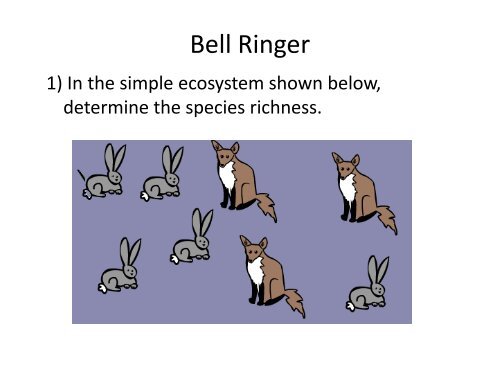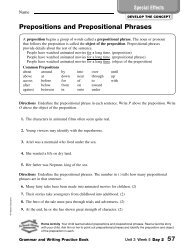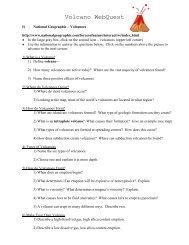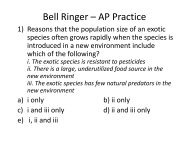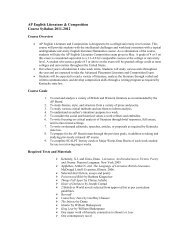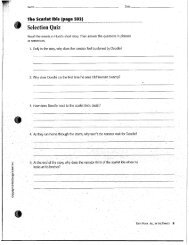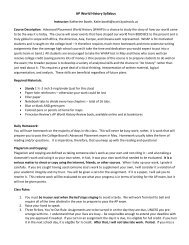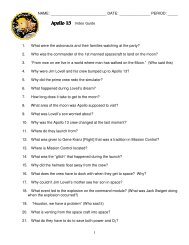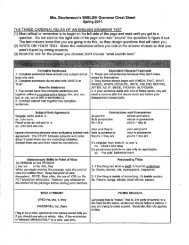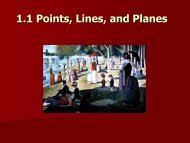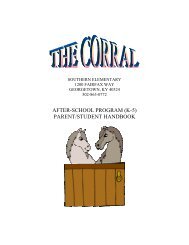Bell Ringer
Bell Ringer
Bell Ringer
Create successful ePaper yourself
Turn your PDF publications into a flip-book with our unique Google optimized e-Paper software.
<strong>Bell</strong> <strong>Ringer</strong><br />
1) In the simple ecosystem shown below,<br />
determine the species richness.
2) “The specific environment in which an<br />
organism lives, including biotic and abiotic<br />
factors” is the definition of which term below?<br />
a) Niche<br />
b) Ecosystem<br />
c) Habitat<br />
d) Biome<br />
e) Community
3) An organism’s role in the flow of energy, its<br />
resource consumption and its species-species<br />
interactions all make up its __________<br />
a) Habitat<br />
b) Niche<br />
c) Ecosystem<br />
d) Biome<br />
e) Predator-prey relationships
4) The graph below best describes which biome?<br />
a) Tropical Dry Forest<br />
b) Tundra<br />
c) Temperate grassland<br />
d) Savanna<br />
e) Tropical Rain Forest
Energy Flow and Food Webs<br />
Pgs 148-150
Energy Movement<br />
• Of all the species-species interactions within<br />
an ecosystem, the most important is the<br />
movement of energy.<br />
• As an organism feeds on another, matter and<br />
energy are moved through the ecosystem.
Energy – Review<br />
• The ultimate source of energy for earth is the Sun.<br />
• Through photosynthesis, autotrophs convert solar<br />
energy into chemical energy in the form of<br />
glucose.<br />
• Autotrophs and heterotrophs then use the process<br />
• Autotrophs and heterotrophs then use the process<br />
of cellular respiration to convert chemical energy<br />
in glucose into ATP.
Energy Movement<br />
• Trophic Level – rank in the feeding (energy)<br />
hierarchy.<br />
• There are three primary trophic levels in every<br />
ecosystem:<br />
– Producers<br />
– Consumers<br />
– Detritivores and decomposers
Trophic Levels<br />
• Producer – an organism that uses energy<br />
from sunlight to produce food.
Trophic Levels<br />
• Producer – an organism that uses energy<br />
from sunlight to produce food.<br />
• Form first trophic<br />
level of any<br />
food chain<br />
• Examples:<br />
Plants, Algae
Trophic Levels<br />
• Primary Consumer – an organism which gets<br />
its energy from producers.<br />
Example: Ants, Caterpillars,<br />
Deer
Trophic Levels<br />
• Secondary Consumer – an organism which<br />
gets its energy from primary consumers.<br />
Example: Birds, Spiders, Lion
Trophic Levels<br />
• Tertiary Consumer – an organism which gets<br />
its energy from secondary consumers.<br />
Example: Owls feed on rodents that feed on grasshoppers
Trophic Levels<br />
• Top – Level Consumer – A consumer at the<br />
top of the food chain.<br />
• (This consumer has no predators).<br />
Example: Humans, Bald Eagles
Trophic Levels<br />
• Detritivores – break down the waste products<br />
or dead bodies of organisms within the<br />
ecosystem.<br />
Example: Millipedes, soil insects<br />
• Decomposers – break down leaf litter and<br />
other nonliving matter into simpler nutrients.<br />
Example: Fungi, Bacteria
Trophic Levels<br />
• Detritivores and Decomposers help recycle<br />
nutrients into the soil and help dispose of<br />
dead organisms.
Food Chains<br />
• Food chain – a linear series of feeding<br />
relationships, showing how energy moves<br />
upward through the trophic levels.
Food Chains<br />
• In a food chain, arrows point toward the<br />
transfer of energy (not to who is eating!)
Food Webs<br />
• A more accurate depiction of how energy<br />
moves through ecosystems is a food web.<br />
• Food web – a visual map of feeding<br />
relationships, highlighting the various paths by<br />
which energy passes among organisms of an<br />
ecosystem.
• Food webs
Creating a Food Web
<strong>Bell</strong> <strong>Ringer</strong><br />
1)The eagle is an example of…<br />
a) Producer<br />
b) Primary Consumer<br />
c) Secondary Consumer<br />
d) Tertiary Consumer<br />
e) Top-Level Consumer
<strong>Bell</strong> <strong>Ringer</strong><br />
2) In this food chain, an<br />
example of a tertiary<br />
consumer would be…<br />
a) Green plants<br />
b) Insects<br />
c) Fish<br />
d) Big Fish<br />
e) Eagle
<strong>Bell</strong> <strong>Ringer</strong><br />
3) What trophic level is<br />
missing from this<br />
food chain?<br />
a) Producers<br />
b) Consumers<br />
c) Detritivores/Decomposers<br />
d) Autotrophs<br />
e) Heterotrophs
<strong>Bell</strong> <strong>Ringer</strong> – AP Practice<br />
4) A decomposer would<br />
recycle nutrients back to a…<br />
a) Producer<br />
b) Detritivore<br />
c) Secondary Consumer<br />
d) Tertiary Consumer<br />
e) Primary Consumer
Creating a Food Web – The LAST Day
Energy Pyramid<br />
• 10% Rule –<br />
Only about 10%<br />
of the energy available<br />
at one trophic level is<br />
transferred to<br />
organisms at the next<br />
trophic level.
Numbers Pyramid<br />
• Numbers pyramids reflect the species evenness<br />
values of an ecosystem.
Numbers Pyramid<br />
• Why are there fewer consumers at the top of<br />
the pyramid compared to the bottom?
Numbers Pyramid<br />
• With the loss of energy occurring at each<br />
level, there is not enough energy to support a<br />
large amount of life at the top of the pyramid.
• Keystone species<br />
• Numbers pyramid<br />
• Invasive species


